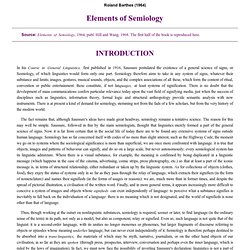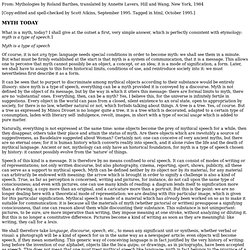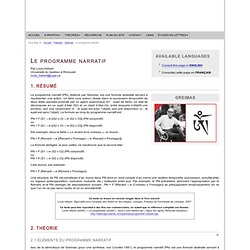

Elements of Semiology by Roland Barthes. Roland Barthes (1964) Source: Elements of Semiology, 1964, publ.

Hill and Wang, 1968. The first half of the book is reproduced here. In his Course in General Linguistics, first published in 1916, Saussure postulated the existence of a general science of signs, or Semiology, of which linguistics would form only one part. Semiology therefore aims to take in any system of signs, whatever their substance and limits; images, gestures, musical sounds, objects, and the complex associations of all these, which form the content of ritual, convention or public entertainment: these constitute, if not languages, at least systems of signification. The fact remains that, although Saussure's ideas have made great headway, semiology remains a tentative science.
Thus, though working at the outset on nonlinguistic substances, semiology is required, sooner or later, to find language (in the ordinary sense of the term) in its path, not only as a model, but also as component, relay or signified. I. I.1.2. Barthes-Myth. From: Mythologies by Roland Barthes, translated by Annette Lavers, Hill and Wang, New York, 1984 [Copy-edited and spell-checked by Scott Atkins, September 1995.

Tagged in html, October 1995.] What is a myth, today? I shall give at the outset a first, very simple answer, which is perfectly consistent with etymology: myth is a type of speech.1 Myth is a type of speech Of course, it is not any type: language needs special conditions in order to become myth: we shall see them in a minute. It can be seen that to purport to discriminate among mythical objects according to their substance would be entirely illusory: since myth is a type of speech, everything can be a myth provided it is conveyed by a discourse. Naturally, everything is not expressed at the same time: some objects become the prey of mythical speech for a while, then they disappear, others take their place and attain the status of myth. Semiotics for Beginners by Daniel Chandler.
Practical Semiotics - Master the Hidden Depths of your Brand. Libreros: Roland Barthes - Retorica de la imagen. Según una etimología antigua, la palabra imagen debería relacionarse con la raíz de imitari.

Henos aquí de inmediato frente al problema más grave que pueda plantearse a la semiología de las imágenes: ¿puede acaso la representación analógica (la) producir verdaderos sistemas de signos y no sólo simples aglutinaciones de símbolos? ¿Puede concebirse un analógico, y no meramente digital? Sabemos que los lingüísticos consideran ajena al lenguaje toda comunicación por analogía, desde el de las abejas hasta el por gestos, puestos que esas comunicaciones no poseen una doble articulación, es decir, que no se basan como los fonemas, en una combinación de unidades digitales.
Semiotics and Cultural Criticism by Arthur Berger. Arthur Asa BergerCultural Criticism: Semiotics and Cultural Criticism In this chapter I address some of the basic concepts in semiotics, to show how it enables us to find meaning in texts and other phenomena.

I try to explain each concept as simply as possible, and I quote extensively from important passages written by various authorities, to give the reader some idea of how these writers express themselves. Signo. Semiotic analysis - proven methods to cut through marketing clutter. Algirdas Julien Greimas : Le programme narratif. Greimas Le programme narratif (PN), élaboré par Greimas, est une formule abstraite servant à représenter une action.

Un faire (une action) réside dans la succession temporelle de deux états opposés produite par un agent quelconque (S1 : sujet de faire). Un état se décompose en un sujet d’état (S2) et un objet d’état (O), entre lesquels s’établit une jonction, soit une conjonction (n : le sujet est avec l’objet), soit une disjonction (u : le sujet est sans l’objet). La formule au long du programme narratif est : [(S2 u O) — (S2 n O)]} (PN conjonctif) ou PN = F {S1 — [(S2 n O) — (S2 u O)]} (PN disjonctif). Par exemple, dans la fable « Le renard et le corbeau », on trouve : PN = F {Renard — [(Renard u Fromage) — (Renard n Fromage)]}. La formule abrégée, la plus usitée, ne mentionne que le second état : (S2 n O)} (PN conjonctif) ou PN = F {S1 — Semionaut Signifying Everything.